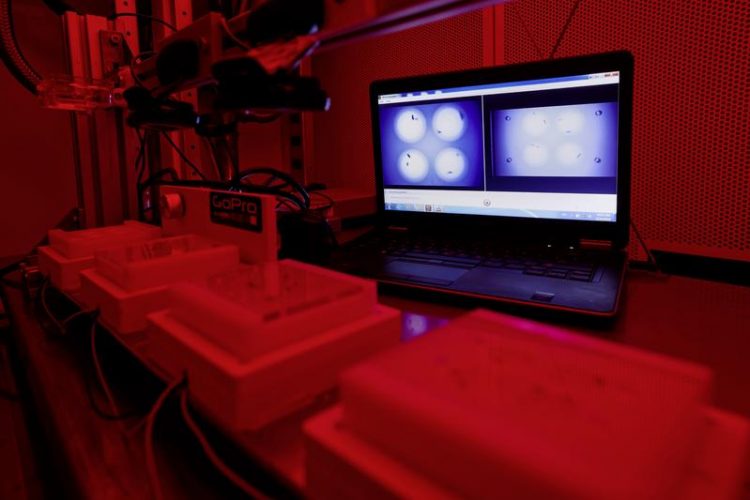The irresistible fragrance of dying vinegar flies

Mating experiments with Drosophila melanogaster: Enhanced sexual attractiveness of sick flies does not lead to reproductive success. Increased pheromone production benefits only the pathogens. Anna Schroll
Markus Knaden and Bill Hansson, and their colleagues at the Department of Evolutionary Neuroethology, study ecologically relevant odors in the natural environment of insects, especially vinegar flies. In this new study they focused on a deadly smell: the odor of conspecifics which have a lethal bacterial infection.
“We had originally hoped to find a dedicated neuronal circuit in the flies which is specialized to detect and avoid sickness odors. Instead we observed that healthy flies were especially attracted to the smell of infected ones. When we realized that flies cannot avoid becoming infected, as sick flies produce particularly high amounts of pheromones, we were surprised but found that even more interesting,” says Markus Knaden, one of the leaders of the study.
State-of-the-art analytical methods enabled the researchers to identify and quantify the odors of single flies. Vinegar flies which suffered from bacterial infection and their feces emitted dramatically increased amounts of the typical odors that attract other flies. The hypothesis that last-minute pheromone emission by sick insects would enhance their reproductive success turned out to be wrong, as mating assays demonstrated that sick flies were barely able to copulate.
Insect immunologist Nicolas Buchon from Cornell University and his team, who were also involved in the study, noticed that the increase in pheromone production matched the up-regulation of certain immune responses in the flies.
Ian Keesey, the first author of the study, and his colleagues in Jena therefore tested mutant flies which lacked the ability to produce these responses and found that these flies emitted far fewer pheromones when they became infected in comparison to sick wild-type flies. Further analysis of the insects’ metabolism convinced the researchers that ongoing bacterial growth and the subsequent damages caused by the pathogens are necessary to induce increases in pheromone production.
The scientists observed similar results when they conducted experiments with other fly species. Seven other Drosophila species as well as the yellow fever mosquito Aedes aegyptii conspecifics dramatically changed their olfactory profile after infection with the pathogen. Manipulation of social communication in insects by pathogenic bacteria seems to be a more general phenomenon in nature than thought.
Markus Knaden hopes that the new insights can one day contribute to useful applications: “A well-established method to combat insect-transmitted diseases and to control agricultural pest insects is the use of pheromone traps. By infecting insects with bacteria we could generally increase their pheromone emission. This could enable us to identify novel pheromones in species that have not been investigated so far.” [AO/KG/EW]
Original Publication:
Keesey, I. W., Koerte, S., Khallaf, M. A., Retzke, T., Guillou, A., Grosse-Wilde, E., Buchon, N., Knaden, M., Hansson, B. S. (2017). Pathogenic bacteria enhance dispersal through alteration of Drosophila social communication. Nature Communications
DOI: 10.1038/10.1038/s41467-017-00334-9
http://dx.doi.org/10.1038/10.1038/s41467-017-00334-9
Further Information:
Prof. Dr. Bill S. Hansson, Max Planck Institute for Chemical Ecology, Hans-Knöll-Str. 8, 07743 Jena, +49 3641 57-1401, E-Mail hansson@ice.mpg.de
Dr. Markus Knaden, Max Planck Institute for Chemical Ecology, Hans-Knöll-Str. 8, 07743 Jena, +49 3641 57-1421, E-Mail mknaden@ice.mpg.de
Contact and Media Requests:
Angela Overmeyer M.A., Max Planck Institute for Chemical Ecology, Hans-Knöll-Str. 8, 07743 Jena, +49 3641 57-2110, E-Mail overmeyer@ice.mpg.de
Download high-resolution images via http://www.ice.mpg.de/ext/downloads2017.html
http://www.ice.mpg.de/ext/index.php?id=evolutionary-neuroethology&L=0 Department of Evolutionary Neuroethology
Media Contact
More Information:
http://www.ice.mpg.de/All latest news from the category: Life Sciences and Chemistry
Articles and reports from the Life Sciences and chemistry area deal with applied and basic research into modern biology, chemistry and human medicine.
Valuable information can be found on a range of life sciences fields including bacteriology, biochemistry, bionics, bioinformatics, biophysics, biotechnology, genetics, geobotany, human biology, marine biology, microbiology, molecular biology, cellular biology, zoology, bioinorganic chemistry, microchemistry and environmental chemistry.
Newest articles

First-of-its-kind study uses remote sensing to monitor plastic debris in rivers and lakes
Remote sensing creates a cost-effective solution to monitoring plastic pollution. A first-of-its-kind study from researchers at the University of Minnesota Twin Cities shows how remote sensing can help monitor and…

Laser-based artificial neuron mimics nerve cell functions at lightning speed
With a processing speed a billion times faster than nature, chip-based laser neuron could help advance AI tasks such as pattern recognition and sequence prediction. Researchers have developed a laser-based…

Optimising the processing of plastic waste
Just one look in the yellow bin reveals a colourful jumble of different types of plastic. However, the purer and more uniform plastic waste is, the easier it is to…



